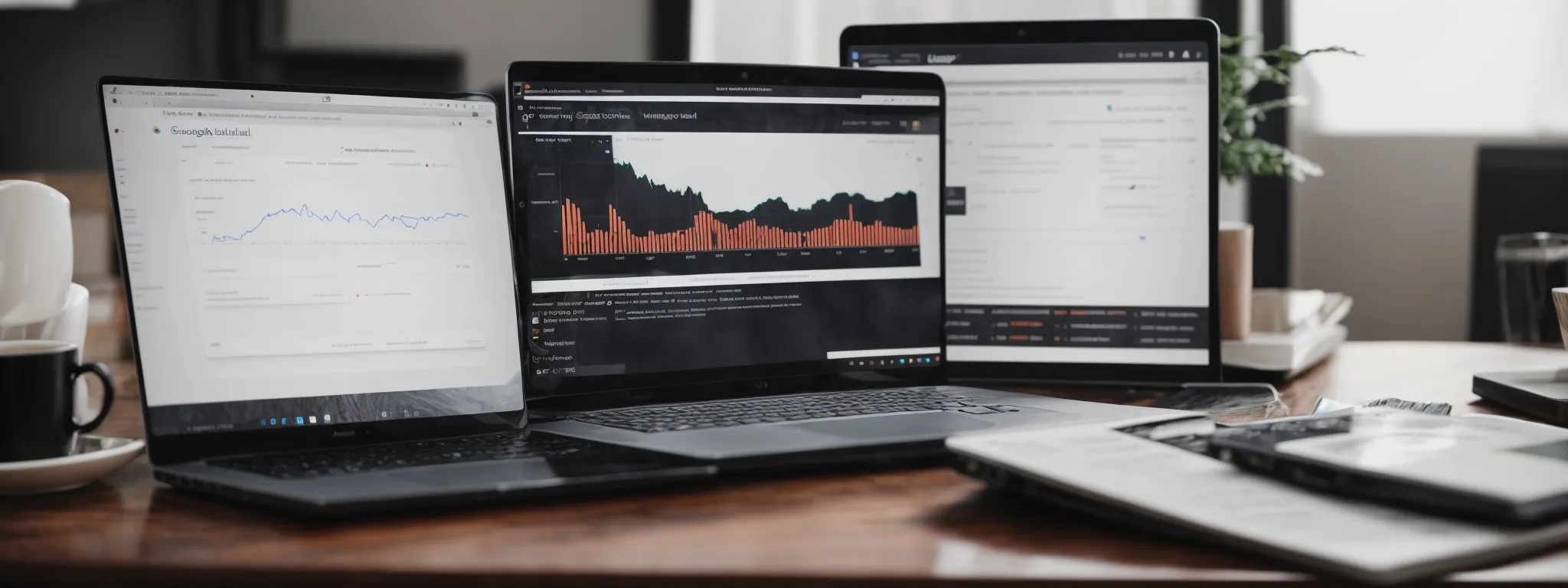SEO vs. Google Ads— Compare and Contrast
SEO vs. Google Ads: Understanding the Differences and Benefits In the evolving landscape of digital marketing, understanding the intricacies of search engine optimization (SEO) and Google Ads […]
SEO vs. Google Ads: Understanding the Differences and Benefits
In the evolving landscape of digital marketing, understanding the intricacies of search engine optimization (SEO) and Google Ads can arm a business owner with the knowledge to leverage the web’s immense potential.
These two cornerstones of online visibility serve distinct purposes: SEO underpins a long-term strategy for organic audience growth, while Google Ads targets immediate visibility through paid clicks.
Navigating through the maze of search terms, conversion rates, and campaign ROI requires a nuanced grasp of each marketing method’s strengths and influence over web page rankings and user engagement.
LinkGraph’s expert services carve out a path to demystifying these channels, ensuring businesses thrive in a competitive online environment.
Keep reading to explore the distinguishable characteristics and collective power of SEO and Google Ads, and how firms like LinkGraph deliver measurable success.
Key Takeaways
- SEO Is a Long-Term Strategy That Improves Organic Traffic and Brand Visibility Through High-Quality Content and Web Design
- Google Ads Provide Immediate, Targeted Visibility With Precise Audience Segmentation, Offering Swift Market Penetration and Timely Promotions
- The Combination of SEO and Google Ads Can Create a Synergistic Impact, Leveraging Insights From Each to Enhance the Overall Digital Marketing Strategy
- A Strategic Mix of SEO and Google Ads Enables Businesses to Optimize Both Long-Term Brand Trust and Immediate Conversion Potential
- LinkGraph’s Services, Including the Use of Search Atlas, Aid Businesses in Efficiently Managing Their SEO and Google Ads Strategies to Maximize ROI
Delineating SEO and Google Ads in Digital Marketing

In the ever-evolving landscape of digital marketing, business owners are continuously faced with the strategic decision of where to allocate their advertising spend for the highest return on investment.
At the core of this decision-making process lie two formidable tools: Search Engine Optimization (SEO) and Google Ads.
While SEO focuses on optimizing a web page to earn organic traffic through higher search engine results page rankings, Google Ads leverages paid search advertising to display your brand’s offerings in Google search results and the Google Display Network.
This introduction sets the stage for an in-depth examination of the underlying goals of both SEO and Google Ads, an analysis of their primary objectives, and a detailed breakdown of the expected timelines for results that accompany each marketing method.
Understanding the Fundamental Goals of SEO
The pursuit of mastering SEO converges on enhancing a web page’s presence in organic search engine results, with the intention to elevate brand visibility and drive SEO traffic. Professionals in the realm of SEO harness a range of techniques—from improving content quality to securing backlinks—in a concerted effort to signal relevance and authority to search engines, thereby aligning with SEO Best Practices.
SEO endeavors extend beyond mere rankings; they are at their core about appreciating the needs and behavior of the target audience. Aligning a website’s landing page with intent-infused search terms allows companies to connect authentically with potential customers, fostering a higher likelihood of achieving a notable conversion rate on their SEO investments.
Examining the Primary Objectives of Google Ads
Google Ads operates with clarity in its objectives – to position a brand at the pinnacle of visibility when users initiate a search. The service deploys text ads, shopping ads, and display ads to catapult a brand’s presence into high-traffic arenas, with expert management to ensure advertisements resonate powerfully with the searcher’s intent.
Central to the Google Ads proposition is the craft of precision targeting – engaging a business’ audience through focused ad campaigns that entice and convert. The platform’s versatility enables advent into diverse advertising campaigns such as PPC campaigns, Google Shopping ads, and remarketing strategies, each backed by data-driven insights to optimize ad spend and escalate conversion rates.
Dissecting the Timelines for Results in Both Strategies
The efficacy of a strategy in digital marketing often hinges on the speed with which it yields results. SEO is traditionally viewed as a long-term marketing strategy, where discernible shifts in ranking and traffic growth can emerge over several months to a year. It’s an organic approach that rewards patience and consistency, as changes to search engine algorithms and evolving SEO best practices can affect the timeframe.
In contrast, Google Ads campaigns have the capability to drive immediate results, given their paid nature. The moment a campaign is activated and funded, ads commence appearing in search result pages, potentially driving traffic and conversions swiftly. This immediacy makes Google Ads an appealing option for brands seeking a speedy uplift in visibility and consumer engagement.
The Financial Commitment: SEO vs Google Ads

When weighing the merits of SEO against the immediacy of Google Ads, one cannot overlook the fiscal dimension of each approach.
Businesses must scrutinize not only how these strategies differ in method and outcome, but equally in their cost implications and financial viability.
The forthcoming discussion delves into the budgets associated with SEO campaigns, contrasting them with the payment structure defining Google Ads.
Ultimately, a company’s mastery over their marketing investment will hinge upon their acumen in calculating the potential return on investment for each of these potent digital marketing methods.
Analyzing the Cost Structure of SEO Efforts
Deciphering the expense landscape for SEO activities is akin to evaluating an investment portfolio. It involves a continuous allocation of resources toward various facets such as content creation, keyword research, and site optimization, all tailored to an ever-changing market. For businesses, the subtlety lies in recognizing that while initial costs may seem daunting, the compounded benefits of Heightened SEO Rankings often justify the expenditure over time.
LinkGraph stands as a beacon for those navigating the cost complexities of SEO efforts. Their SEO Services Pivot on Delivering Measurable Value, equipping businesses with the tools, such as Search Atlas, necessary to track progress and manage investments efficiently. Clients are thus primed to gauge the gradual improvement in their SEO strategy’s ROI, all while ensuring funds are channeled into the most impactful initiatives.
Breaking Down the Payment Model for Google Ads
Google Ads operates on a pay-per-click (PPC) model, meaning businesses only incur a cost when a user actively engages with an advertisement, such as clicking through to a landing page. This performance-based approach allows companies to manage their ad spend efficiently, as their investment directly correlates with consumer interaction.
LinkGraph emphasizes how mastering the Google Ads payment structure can lead to optimization of ad campaigns, thus maximizing the return on each dollar expended. With its adept handling of advertising budgets, the firm equips clients to target their intended audience and measure the impact of each ad via precise analytics provided by platforms like Search Atlas.
Calculating ROI for Both Digital Marketing Methods
Calculating return on investment for SEO and Google Ads hinges on a comprehensive analysis of multiple metrics, including traffic, conversion rate, and the resulting revenue. While SEO investments unfold their worth over time, culminating in increased organic reach and sustained lead generation, the ROI of Google Ads is readily apparent through immediate traffic influxes and conversions directly tied to the frequency and targeting efficiency of ads.
Business owners evaluating the efficiency of their marketing campaign must consider the long-term value of SEO against the immediate results yielded by Google Ads. LinkGraph assists in this endeavor by providing advanced tools like Search Atlas, enabling firms to accurately ascertain the value each method brings and forecasting future budget allocations with an informed perspective on prospective ROI from their SEO campaign or Google Ads initiative.
Traffic Generation: Organic Searches and Paid Clicks

Within the digital marketing ecosystem, traffic generation acts as the lifeblood of online visibility, empowering brands to reach a wider audience and engage with consumers more effectively.
The distinction between organic searches, nurtured through SEO, and the expedient clicks garnered via Google Ads looms large for companies seeking to maximize their online footprint.
This subsection outlines the essence of traffic acquisition through both avenues, exploring the intrinsic nature of organic search traffic, the prompt results of paid Google Ads, and weighing the long-term sustainability of each traffic source within the broader context of a comprehensive marketing strategy.
Exploring the Nature of Traffic From SEO
Traffic stemming from SEO efforts unfolds in a rich tapestry of organic discovery. This type of traffic is built through the meticulous optimization of web design, the Strategic Deployment of Keywords, and nurturing a repository of high-quality content that resonates with the target audience.
As consumers engage with search engines, the visibility of a brand’s SEO-friendly Web Pages intensifies, leading to a growth in organic visits: those not prompted by paid ads but by natural relevance and user preference. Such visits often signify a deep alignment with the searcher’s intent, making them potentially more valuable in their propensity to convert:
| Traffic Source | User Intent Alignment | Propensity to Convert |
|---|---|---|
| Organic SEO Traffic | High | Potentially More Valuable |
| Paid Google Ads Traffic | Variable | Dependent on Ad Relevance |
Delving Into the Immediacy of Traffic From Google Ads
The immediacy of traffic from Google Ads is one of its most compelling advantages. As advertisers launch campaigns, their ads become visible to users within a matter of hours, offering a rapid increase in web page visits and the potential for immediate conversion uplift.
With this velocity, Google Ads emerges as an impactful tool for firms intent on swift market penetration or for those who aim to capitalize on time-sensitive promotions. LinkGraph ensures clients can tap into this immediate traffic surge, tailoring campaigns that synchronize seamlessly with business objectives and audience dictates.
Discussing the Sustainability of Traffic Sources
The long-term sustainability of a traffic source is a critical consideration for any marketing strategy. SEO typically provides enduring visibility, as content that achieves high rankings can continue to attract organic traffic over time, representing a lasting asset in a company’s digital marketing arsenal.
| Traffic Source | Long-Term Sustainability |
|---|---|
| SEO (Organic Traffic) | High |
| Google Ads (Paid Traffic) | Dependent on Ongoing Investment |
Conversely, the life span of traffic from Google Ads is directly linked to the continuity of investment. While capable of delivering immediate results, this traffic source requires consistent funding to maintain its presence, necessitating a calculated balance between short-term gains and long-term budgetary considerations.
SEO and Google Ads: Which Enhances Visibility More?

In the dynamic realm of online marketing, discernment between the long-term exposure afforded by SEO and the prompt visibility proffered by Google Ads is essential for businesses aiming to optimize their digital presence.
This exploration scrutinizes the apparent dichotomy, emphasizing the enduring nature of SEO in cultivating a brand’s online footprint and the expedient, targeted approach of Google Ads to capture immediate audience attention.
As such, the ensuing dialogue unfolds, contrasting both strategies in their capacity to engage targeted groups effectively, shedding light on which avenue might elevate a brand’s visibility to its zenith.
The Long-Term Visibility Potential of SEO
The Long-Term Visibility Potential of SEO embodies the concept of building an enduring online presence that continues to yield dividends well into the future. By adhering to SEO best practices and cultivating a robust repository of high-quality content, businesses ensure their web pages remain relevant and authoritative in the eyes of search engines and users alike.
With SEO, companies solidify their search engine rankings, which translates to sustained organic discoverability and a consistent influx of visitors. This strategy fosters a strong brand image and trust with consumers, establishing a foundation for long-term success within the competitive digital landscape:
| Strategy | Visibility | Duration |
|---|---|---|
| SEO | Enduring Organic Presence | Long-Term |
| Google Ads | Immediate Targeted Exposure | Short-Term (Ad Duration) |
Achieving Quick Visibility With Google Ads
Achieving swift visibility is a hallmark of Google Ads, a feature invaluable for businesses looking to make an immediate impact in the market. Through carefully crafted ad campaigns, Google Ads can catapult a brand’s name to the top of the search engine results page, garnering instant attention from prospective customers.
Google Ads’ systems provide the facility to target specific demographics, interests, and even geographic locations, enabling a company to tailor its message to the most receptive audience. This level of customization in advertising ensures that visibility is not only quick but also relevant, enhancing the likelihood of user engagement and conversion.
Comparing the Audience Targeting Capabilities
The stratification of audience targeting between SEO and Google Ads underscores a fundamental distinction in approach. SEO seeks to capture the traffic of users already seeking information or products related to a brand’s offering, whereas Google Ads allows precise targeting based on user data, such as demographics, interests, and past online behavior.
Google Ads provides immediate control over the visibility of a brand’s campaigns, delivering tailored messages directly to the search results of a defined audience. On the contrary, SEO depends on organic growth and relevance, gradually nurturing an audience that encounters a brand through the natural course of their search activities.
User Experience: Organic Content vs Sponsored Ads

Within the expansive domain of online marketing, there’s a palpable distinction between the user-centric approach of SEO and the targeted persuasion harnessed by Google Ads.
Each plays a pivotal role in how potential customers interact with a brand, yet they differ fundamentally in their portrayal of content and advertisements.
While SEO focuses on organically enhancing the user experience through relevant and authoritative information, Google Ads centers on capturing attention with prominently placed sponsored content.
In assessing the culmination of user experience optimization, it is imperative for marketers to weigh the authenticity that SEO imbues against the strategic allure that Google Ads command.
This evaluation will unpack the intrinsic nuances of user engagement inherent in these discrete yet complementary facets of a sophisticated digital marketing strategy.
The Role of SEO in Enhancing User Experience
The Role of SEO in Enhancing User Experience begins with the inherent nature of providing users what they seek: valuable, relevant content aligned with their search intent. SEO’s commitment to elevating content quality not only improves a brand’s SERP rankings but also graciously steers users toward helpful information, cultivating a positive experience and fostering brand trust:
| Marketing Strategy | User Experience Focus | Content Relevance |
|---|---|---|
| SEO | High | Aligned with Search Intent |
| Google Ads | Targeted | Sponsored Relevance |
Furthermore, SEO underpins the seamless usability of websites by Optimizing Web Design and Structure, contributing to an intuitive and engaging user journey. A site that is easy to navigate not only pleases visitors but also signals to search engines the inherent value of user-centric design, thereby reinforcing the symbiotic relationship between SEO and user experience.
Understanding User Interaction With Google Ads
User interaction with Google Ads is marked by the strategic placement and timing of these sponsored messages. When users engage with these ads, they are often directed to a curated landing page, where their needs are anticipated and matched with the business’s products or services, creating a streamlined path towards conversion.
Google Ads can provide a significant boost in visibility by targeting specific segments of the audience who are more likely to exhibit interest in the brand’s offerings. This targeted approach can result in a higher click-through rate (CTR), as ads are tailored based on a user’s previous interactions, search history, and preferences, creating a touchpoint that feels both timely and relevant to the consumer.
Balancing Authenticity and Persuasion in Both Strategies
In the intricate dance of digital marketing, authenticity in Organic Content and the Persuasive Power of Sponsored Ads must harmonize to engage the consumer effectively. SEO emboldens this authenticity by aligning content with user search queries, engendering trust and connection without the overt feel of a hard sell. Conversely, Google Ads wields persuasion by placing a brand directly in the sightline of potential customers, employing strategic messaging to incite interest and action.
The challenge for businesses utilizing both SEO and Google Ads lies in crafting a cohesive narrative that respects the user’s desire for authenticity while also capitalizing on the catalyst of persuasion. By optimizing for search engines, a brand’s relevance organically surfaces, whereas, with Google Ads, the brand’s story is assertively told, creating a dynamic interplay that serves to inform, entice, and ultimately convert the audience.
Integrating SEO With Google Ads for Synergistic Results

In the intricate world of digital marketing, the fusion of search engine optimization and Google Ads stands as a formidable alliance, enhancing the potency of both strategies.
While SEO offers a wealth of organic insights that can significantly amplify the effectiveness of paid campaigns, the actionable data harvested from Google Ads provides invaluable intelligence to refine and inform SEO endeavors.
By orchestrating a cohesive digital marketing approach, business entities can harness the combined strength of both avenues to achieve a synergistic impact, resulting in a comprehensive presence across multiple consumer touchpoints.
This integration bears the promise of crafting a singular, powerful narrative that propels brand awareness and drives conversion.
Boosting Google Ads Performance Using SEO Insights
Integrating SEO with Google Ads offers a strategic advantage, as insights from organic search can enhance the precision of paid campaigns. By analyzing the performance of various SEO tactics, such as keyword rankings and user behavior on organic search, businesses can glean data that refines their Google Ads targeting and messaging.
The synergy between SEO and Google Ads becomes evident when the granular details from SEO analytics inform the optimization of paid ad campaigns. Organic search data guides advertisers in crafting Google Ads that resonate more effectively with their audience, often leading to improved ad relevance and a higher click-through rate:
- Utilizing high-performing organic keywords to inform PPC ad keywords selection.
- Assessing the engagement metrics of organic content to optimize Google Ads copy.
- Harvesting audience insights from SEO to tighten demographic targeting in Google Ads.
Using Google Ads Data to Refine SEO Strategies
Conversely, Google Ads data offers actionable insights that can significantly refine an SEO strategy. The empirical performance of ad campaigns provides a wealth of information on which search terms and advertising messages yield the highest engagement and conversions, thereby illuminating opportunities for SEO content and keyword optimization.
| Data Source | Insight | Application to SEO |
|---|---|---|
| Google Ads | Top-Performing Keywords | Organic Content Optimization |
| Google Ads | CTR and Conversion Data | Meta Descriptions and Title Tags Refinement |
Discoveries from PPC campaigns about user preferences and conversion triggers can be mirrored in organic SEO tactics to enhance the user journey and improve organic rankings. LinkGraph’s integration of Google Ads data into SEO campaigns encapsulates a holistic approach to digital marketing, allowing firms to harness the potency of customer journey insights across both paid and organic touchpoints.
Crafting a Cohesive Digital Marketing Approach
In an era where digital intricacies define market success, a cohesive digital marketing approach transcends the binary choice between SEO and Google Ads. Leading firms employ a strategic mix, leveraging the nuanced analytics and audience targeting prowess of Google Ads alongside the content richness and organic resonance of SEO, thus forging a unified, powerful front in the digital sphere.
LinkGraph exemplifies this synthesis, guiding its clients through the convergence of search engine optimization and paid advertising strategies. This concerted approach ensures that every facet of online presence, from the subtleties of a well-crafted ad to the depth of an SEO-enriched webpage, works in tandem to enhance brand visibility and drive measurable growth in consumer engagement and ROI.
Conclusion
In conclusion, the decision between investing in SEO or Google Ads within the digital marketing space is not a matter of choosing one over the other, but rather understanding the distinct benefits and differences each brings to the table.
SEO is a long-term strategy focused on building organic traffic through high-quality content and search engine alignment, leading to sustained visibility and authentic user engagement.
On the other hand, Google Ads provides immediate, targeted exposure and the ability to swiftly attract potential customers through paid clicks, making it ideal for rapid market impact and short-term goals.
The integration of SEO insights can significantly improve Google Ads campaigns, while data from Google Ads can refine SEO strategies, highlighting the symbiotic relationship between the two.
Consequently, a cohesive approach that leverages both SEO for long-term growth and Google Ads for immediate results can yield a powerful, synergistic effect that enhances overall digital marketing efforts, driving performance, and maximizing ROI.
Effective digital marketing requires the strategic use of both methods, adapting to a brand’s evolving needs and the ever-changing digital landscape.














































































